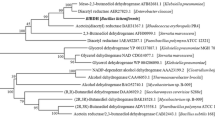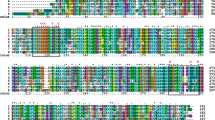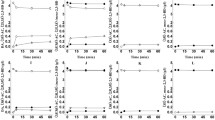Abstract
The budC gene coding for a new meso-2,3-butanediol dehydrogenase (BDH) from Serratia marcescens H30 was cloned and expressed in Escherichia coli BL21(DE3), purified, and characterized for its properties. The recombinant BDH with a molecular weight of 27.4 kDa exhibited a reversible transformation between acetoin and 2,3-butanediol. In the presence of NADH, BDH could catalyze the reduction of diacetyl and (3R)-acetoin to (3S)-acetoin and meso-2,3-butanediol, respectively, while (3S)-acetoin as a substrate could be further transformed into (2S, 3S)-2,3-butanediol at pH 9.0. For diol oxidation reactions, (3R)-acetoin and (3S)-acetoin were obtained when meso-2,3-butanediol and (2S,3S)-2,3-butanediol were used as the substrates with BDH and NAD+. (2R,3R)-2,3-butanediol was not a substrate for the BDH at all. The low K m value (4.1 mM) in meso-2,3-butanediol oxidation reaction and no activity for diacetyl, acetoin, and 2,3-butanediol as the substrates with NADP+/NADPH suggested that the budC gene product belongs to a NAD(H)-dependent meso-2,3-BDH. Maximum activities for diacetyl and (3S/3R)-acetoin reduction were observed at pH 8.0 and pH 5.0 while for meso-2,3-butanediol oxidation it was pH 8.0. However, the optimum temperature for oxidation and reduction reactions was about 40 °C. In addition, the BDH activity for meso-2,3-butanediol oxidation was enhanced in the presence of Fe2+ and for diacetyl and (3S/3R)-acetoin reduction in the presence of Mg2+ and Mn2+, while several metal ions inhibited its activity, particularly Fe3+ for reduction of diacetyl and acetoin. Sequence analysis showed that the BDH from S. marcescens H30 possessed two conserved sequences including the coenzyme binding motif (GxxxGxG) and the active-site motif (YxxxK), which are present in the short-chain dehydrogenase/reductase superfamily.





Similar content being viewed by others
References
Borim K, Lee S, Park J, Lu M, Oh M, Kim Y, Lee J (2012) Enhanced 2,3-butanediol production in recombinant Klebsiella pneumoniae via overexpression of synthesis-related genes. J Microbiol Biotechnol 22(9):1258–1263
Celinska E, Grajek W (2009) Biotechnological production of 2,3-butanediol—current state and prospects. Biotechnol Adv 27:715–725
De Mas C, Jansen NB, Tsao GT (1987) Production of optically active 2,3-butanediol by Bacillus polymyxa. Biotechnol Bioeng 31:366–377
Gonzalez E, Rosario Fernanzdez M, Larroy C, Lluis S, Pericas MA (2000) Characterization of a (2R,3R)-2,3-butanediol dehydrogenase as the Saccharomyces cerevisiae YAL060W gene product. J Biol Chem 275(46):35876–35885
Han SH, Lee JE, Park K, Park YC (2013) Production of 2,3-butanediol by a low-acid producing Klebsiella oxytoca NBRF4. New Biotechnol 30(2):166–172
Ji XJ, Huang H, Du J, Zhu JG, Ren LJ, Hu N, Li S (2009) Enhanced 2,3-butanediol production by Klebsiella oxytoca using a two-stage agitation speed control strategy. Bioresoure Technol 100:3410–3414
Ji XJ, Huang H, Ouyang PK (2011) Microbial 2,3-butanediol production: a state-of-the-art review. Biotechnol Adv 29:351–364
Jornvall H, Persson B, Krook M, Atrian S, Gonzalez-Duarte R, Jeffery J, Ghosh D (1995) Short-chain dehydrogenase/reductases (SDR). Biochemistry 34:6003–6013
Kallberg Y, Oppermann U, Jornvall H, Persson B (2002) Short-chain dehydrogenase/reductases (SDRs): coenzyme-based functional assignments in completed genomes. Eur J Biochem 269:4409–4417
Li LX, Wang Y, Zhang LJ, Ma CQ, Wang AL, Tao F, Xu P (2011) Biocatalytic production of (2S,3S)-2,3-butanediol from diacetyl using whole cells of engineered Escherichia coli. Bioresource Technol 115:111–116
Liu Z, Qin JY, Gao C, Hua DL, Ma CQ, Li LX, Wang Y, Xu P (2011) Production of (2S,3S)-2,3-butanediol and (3S)-acetoin from glucose using resting cells of Klebsiella pneumonia and Bacillus subtilis. Bioresource Technol 102:10741–10744
Nicholson WL (2008) The Bacillus subtilis ydjL (bdhA) gene encodes acetoin reductase/2,3-butanediol dehydrogenase. Appl Environ Microbiol 74(22):6832–6838
Rao B, Zhang LY, Sun JA, Su G, Wei DZ, Chu J, Zhu JW, Shen YL (2012) Characterization and regulation of the 2,3-butanediol pathway in Serratia marcescens. Appl Microbiol Biotechnol 93(5):2147–2159
Sun JA, Zhang LY, Rao B, Shen YL, Wei DZ (2012) Enhanced acetoin production by Serratia marcescens H32 with expression of a water-forming NADH oxidase. Bioresource Technol 119:94–98
Syu MJ (2011) Biological production of 2,3-butanediol. Appl Microbiol Biotechnol 55:10–18
Takusagawa Y, Otagiri M, Ui S, Ohtsuki T, Mimura A, Ohkuma M, Kudo T (2001) Purification and characterization of l-2,3-butanediol dehydrogenase of Brevibacterium saccharolyticum C-1012 expressed in Escherichia coli. Biosci Biotechnol Biochem 65(8):1876–1878
Ui S, Masuda H, Muraki H (1983) Laboratory-scale production of 2,3-butanediol isomers (D(−)), L(+), and (meso) by bacterial fermentations. J Ferment Technol 61:253–259
Ui S, Okajima Y, Mimura A, Kanai H, Kudo T (1997) Molecular generation of an Escherichia coli strain producing only the meso-isomer of 2,3-butanediol. J Ferment Bioeng 84:185–189
Ui S, Otagiri M, Mimura A, Dohmae N, Takio K, Ohkuma M, Kudo T (1998) Cloning, expression and nucleotide sequence of the l-2,3-butanediol dehydrogenase gene from Brevibacterium saccharolyticum C-1012. J Ferment Bioeng 86(3):290–295
Ui S, Takusagawa Y, Sato T, Ohtsuki T, Mumura A, Ohkuma M, Kudo T (2004) Production of l-2,3-butanediol by a new pathway constructed in Escherichia coli. Lett Appl Microbiol 39:533–537
Xiao ZJ, Xu P (2007) Acetoin metabolism in bacteria. Crit Rev Microbiol 33:127–140
Xiao ZJ, Lv CJ, Gao C, Qin JY, Ma CQ, Liu Z, Liu PH, Li LX, Xu P (2010) A novel whole-cell biocatalyst with NAD+ regeneration for production of chiral chemicals. PLoS One 5(1):e8860
Yan YJ, Lee CC, Liao JC (2009) Enantioselective synthesis of pure (R, R)-2,3-butanediol in Escherichia coli with stereospecific secondary alcohol dehydrogenases. Org Biomol Chem 7:3914–3917
Yu B, Sun JB, Bommareddy RR, Song LF, Zeng AP (2011) Novel (2R,3R)-2,3-butanediol dehydrogenase from potential industrial strain Paenibacillus polymyxa ATCC 12321. Appl Environ Microbiol 77(12):4230–4233
Yu EKC, Saddler JN (1983) Fed-batch approach to production of 2,3-butanediol by Klebsiella pneumoniae grown on high substrate concentrations. Appl Environ Microbiol 46:630–635
Zeng AP, Biebl H, Deckwer WD (1990) Effect of pH and acetic acid on the growth and 2,3-butanediol of Enterobacter aerogenes in continuous culture. Appl Microbiol Biotechnol 33(5):485–489
Zhang GL, Wang CW, Li C (2012) Cloning, expression and characterization of meso-2,3-butanediol dehydrogenase from Klebsiella pneumoniae. Biotechnol Lett 34:1519–1523
Zhang LY, Yang YL, Sun JA, Shen YL, Wei DZ, Zhu JW, Chu J (2010) Microbial production of 2,3-butanediol by a mutagenized strain of Serratia marcescens H30. Bioresource Technol 101:1961–1967
Acknowledgments
This work was supported by the Open Funding Project of the State Key Laboratory of Bioreactor Engineering, the Natural Science Foundation of Fujian Province of China (no. 2011J05048) and Science Fund of the Provincial Education Department of Fujian Province of China (no. JA11089).
Author information
Authors and Affiliations
Corresponding authors
Rights and permissions
About this article
Cite this article
Zhang, L., Xu, Q., Zhan, S. et al. A new NAD(H)-dependent meso-2,3-butanediol dehydrogenase from an industrially potential strain Serratia marcescens H30. Appl Microbiol Biotechnol 98, 1175–1184 (2014). https://doi.org/10.1007/s00253-013-4959-x
Received:
Revised:
Accepted:
Published:
Issue Date:
DOI: https://doi.org/10.1007/s00253-013-4959-x




